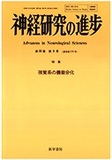Japanese
English
- 有料閲覧
- Abstract 文献概要
- 1ページ目 Look Inside
I.はじめに
対象を視覚的に認知するために第一に重要な大脳部位は左右大脳半球の後頭葉である。視覚情報入力は,後頭葉の第一次視覚野(Brodmann 17野)に達し,その後周辺の視覚前野・視覚周辺野(Brodmann 18・19・37野)で処理される。物の形,人の顔などの形態や,色彩などの視覚情報はほとんどがこれらの後頭葉(一部側頭葉)視覚野で処理され,認知される。後頭・側頭葉病変で物体失認,相貌失認,大脳性色覚障害が生ずることも,後頭・側頭葉が物の形,人の顔などの形態や色彩の視覚的認知に大きな役割を果たしている重要な根拠である。
一方,文字の視覚的認知の座は,古くから左頭頂葉の後方下部である角回にあるとされている。Dejerine(1891)が左角回の梗塞病変で失読失書を呈した剖検例を記載して以来,この説は現在でも有力である。すなわち,文字は後頭・側頭葉で形態として知覚され,その後,頭頂葉に至って初めて文字として認知されると考えられている。これに加え,最近本邦で,左側頭葉の後方下部である下側頭回後部病変で失読失書が生じ,障害の程度が仮名に比較して漢字に強いことが明らかにされた(岩田,1988,1990)。すなわち,左頭頂葉と同様に左側頭葉が文字の視覚認知に関係しているという新しい説が示された。
We investigated the functional roles of the occipital, temporal and parietal lobes in visual recogni-tion of characters by examining the impairment of visual recognition of characters in cases with pure alexia, alexia with agraphia and deep dyslexia. The patterns of impairment of kanji and kana observed in these three types of reading/writing disorders shed light on the brain mechanism in visual recogni-tion of Japanese characters.
1. Pure alexia
Four pure alexic patients, two classical type cases with the splenial lesions, two non-classical type cases whose lesions were localized either in the left infero-lateral portion of posterior cornu or in the left subangular area, served as subject. The mechanism of impairment in pure alexia of both types can be explained by the disconnection syndrome where visual information about characters from the left and right occipital lobes is disrupted the route to left (dominant) angular gyrus. Most of our pure alexic cases showed reading impairment both in kanji and kana, but some cases showed selective impairment in kana (Case 1) or in kanji (Case 2) suggesting that the neurological incoming routes to the angular gyrus for kanji and kana are partially different.

Copyright © 1991, Igaku-Shoin Ltd. All rights reserved.


